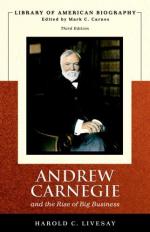
|
| Name: _________________________ | Period: ___________________ |
This quiz consists of 5 multiple choice and 5 short answer questions through Triumph and Tragedy.
Multiple Choice Questions
1. Whose pioneering skills in management are codified in his "Book of Rules and the Employees' Timetable?"
(a) David McClure's.
(b) Daniel McCallum's.
(c) Darrel McAllister's.
(d) Duane McMahon's.
2. The business is _______________ with conductors and station agents collecting millions in small coin revenue.
(a) Penny and dime."
(b) Dime and quarter."
(c) "Penny and nickel."
(d) "Nickel and dime."
3. After this steel company's acquisition for _____ million bonds, Frick restructures all the related companies with Carnegie Steel Company, Limited taking over assets of Carnegie Brothers and Carnegie Phipps with a $25 million capital base, distributing to Carnegie 55 percent, Frick and Phipps both 11 percent each, 1 percent each to nineteen partners and 4 percent reserve for key staff.
(a) $2.
(b) $4.
(c) $3.
(d) $1.
4. Only how many of the original nine partners remain?
(a) Two.
(b) Five.
(c) Three.
(d) Four.
5. Carnegie corrects this deficiency by integrating _______________________.
(a) Keystone Bridge and Union Iron.
(b) Pennsylvania Railroad with Pacific Union.
(c) Pullman and Woodruff.
(d) Sun Oil and US Oil.
Short Answer Questions
1. When prosperity returns, the Carnegie business thrives. Does the damage to his personal reputation from the strike ever heal?
2. Carnegie works ___________ years at the Pennsylvania Railroad while he develops managerial skill, economic principles and personal relationships to become a successful manager, capitalist and entrepreneur.
3. Scott leaves Carnegie in charge when he does what?
4. Frick's chairmanship of the Carnegie Company marks a difficult period in its history starting with what strike in 1892 and a four year depression from 1893.
5. Americans in the North have how many years of peace and prosperity as they begin to exploit American markets?
|
This section contains 270 words (approx. 1 page at 300 words per page) |

|




